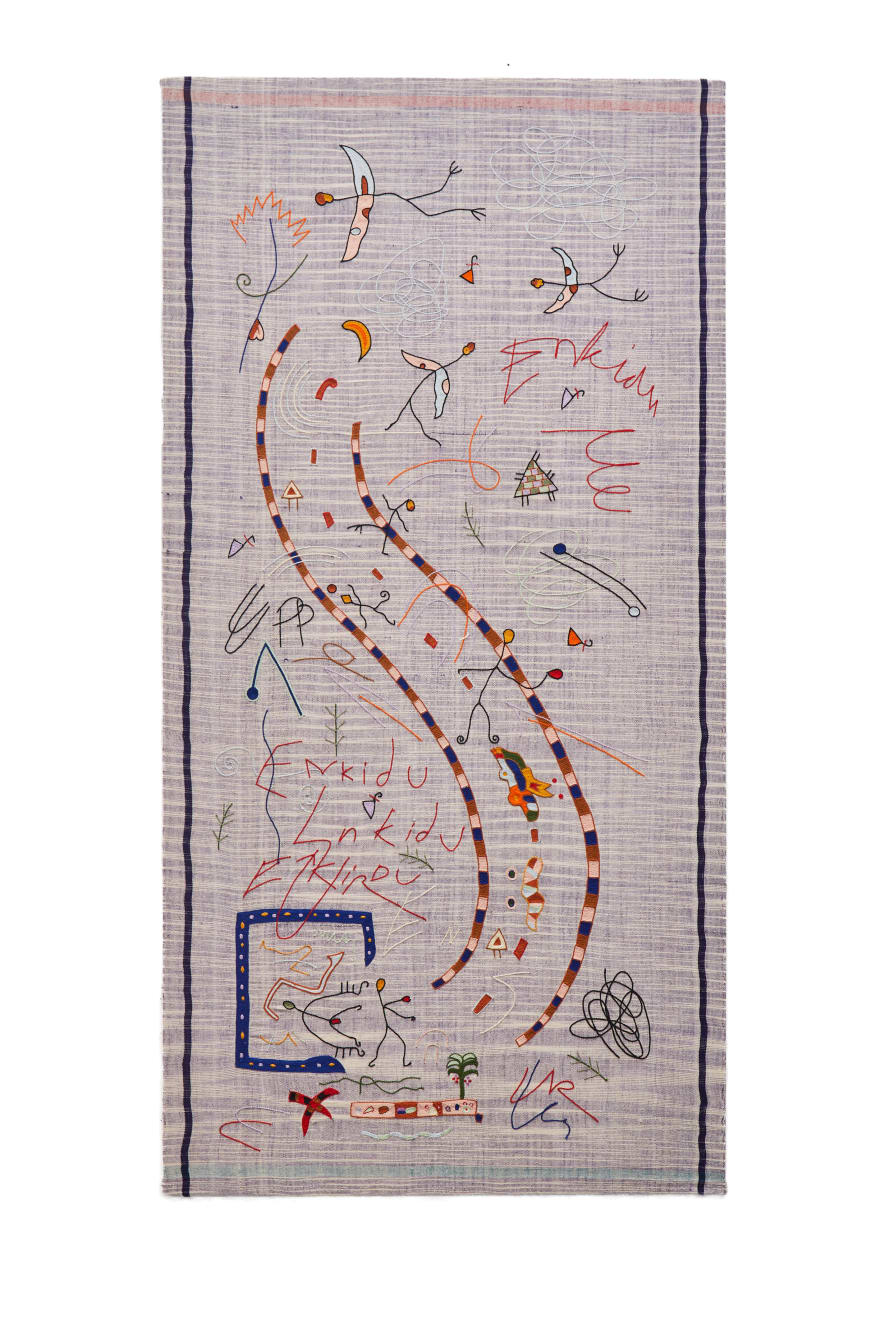Areez Katki b. 1989
Oneiria: Night 5, 2022
Cotton embroidery on khadi towel
(HSN Code: 970110)
(HSN Code: 970110)
53.5 x 28.2 inches
Copyright Areez Katki, 2022
As a brief overview of the Oneria series, it is imperative to mention that the intricate exercises that went toward realizing these panels began during a period of emotional and...
As a brief overview of the Oneria series, it is imperative to mention that the intricate exercises that went toward realizing these panels began during a period of emotional and psychological unease in late-2021 and early-2022, which coincided with Katki’s research as he revisited the contents of Tablet IV from the Epic of Gilgamesh, where Gilgamesh and his companion Enkidu embark on a journey, sharing intimations of anxiety and dread after each dream that Gilgamesh had over five successive nights.
Katki, while studying the contents of this tablet, looked at it as a space suspended in queer temporality, a time out of time, when the pace of the epic poem was changed, contracted in a pseudo-episodic story-within-a-story narrativization. Over five successive nights, this chapter unfolded as Enkidu built Gilgamesh a ‘house for dreaming’ each night as they camped along the foothills of Mount Lebanon in order to reach deeper into the forest to slay Humbaba the destructive cedar god. As Gilgamesh dreamt each night in this soft encampment—which Katki imagined to be constructed from simple bolts of domestic cloth and wood—Enkidu guarded its entrance and waited for his beloved to awake, each morning, with a dreadful fear based on the visions of apocalyptic destruction that would befall them in each dream: loss, abduction, theft, disease, disaster. While closely studying the literary richness of these ancient conversations between lovers, after each night, Katki began to exercise his own psychoanalytic dream-keeping diary. This is where he found his own anxieties unfurl: premonitions of loss, death and fear unfolding in surreal cinematic visions that were then transcribed, illustrated and eventually embroidered over five bolts of khadi.
The last panel, Night 5 from the Oneiria series is uniquely composed: it is to be read against gravitational law, so from bottom to top. A repetition of the abduction motif features again, in the form of an urban accident in this dream. Annotated in Katki’s notes for this dream, we see an intimate enclosure where one reclined figure (his ex-partner) is shown grasping for a figure who walks away and out onto the street. As the figure is shown crossing the street, he is hit by a car and goes seemingly flying into the air. In this dream, Katki’s body, instead of succumbing to fall and injury, soars into the sky and grows anthropomorphic birdlike features, such as talons and wings. The figure is then shown morphing into a celestial being who flies upward, nearly exiting the composition of this final panel. While this bears some allusions to the dreams from Gilgamesh’s Tablet IV, psychoanalytic interpretations of Katki’s own subconscious may profess an anxiety and distress that seeks placation and solace. The subconscious message, interpreted here, is that one might find the potential for growth and renewal—even in the faces of great loss and disaster.
Katki, while studying the contents of this tablet, looked at it as a space suspended in queer temporality, a time out of time, when the pace of the epic poem was changed, contracted in a pseudo-episodic story-within-a-story narrativization. Over five successive nights, this chapter unfolded as Enkidu built Gilgamesh a ‘house for dreaming’ each night as they camped along the foothills of Mount Lebanon in order to reach deeper into the forest to slay Humbaba the destructive cedar god. As Gilgamesh dreamt each night in this soft encampment—which Katki imagined to be constructed from simple bolts of domestic cloth and wood—Enkidu guarded its entrance and waited for his beloved to awake, each morning, with a dreadful fear based on the visions of apocalyptic destruction that would befall them in each dream: loss, abduction, theft, disease, disaster. While closely studying the literary richness of these ancient conversations between lovers, after each night, Katki began to exercise his own psychoanalytic dream-keeping diary. This is where he found his own anxieties unfurl: premonitions of loss, death and fear unfolding in surreal cinematic visions that were then transcribed, illustrated and eventually embroidered over five bolts of khadi.
The last panel, Night 5 from the Oneiria series is uniquely composed: it is to be read against gravitational law, so from bottom to top. A repetition of the abduction motif features again, in the form of an urban accident in this dream. Annotated in Katki’s notes for this dream, we see an intimate enclosure where one reclined figure (his ex-partner) is shown grasping for a figure who walks away and out onto the street. As the figure is shown crossing the street, he is hit by a car and goes seemingly flying into the air. In this dream, Katki’s body, instead of succumbing to fall and injury, soars into the sky and grows anthropomorphic birdlike features, such as talons and wings. The figure is then shown morphing into a celestial being who flies upward, nearly exiting the composition of this final panel. While this bears some allusions to the dreams from Gilgamesh’s Tablet IV, psychoanalytic interpretations of Katki’s own subconscious may profess an anxiety and distress that seeks placation and solace. The subconscious message, interpreted here, is that one might find the potential for growth and renewal—even in the faces of great loss and disaster.

